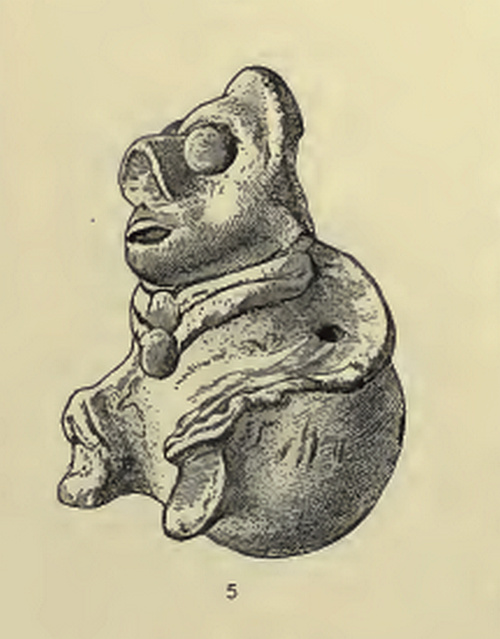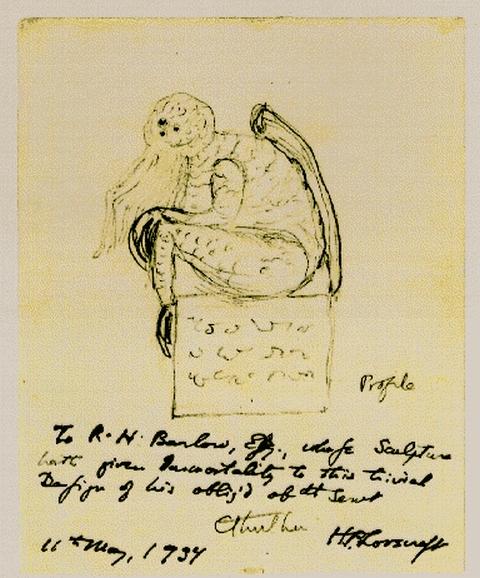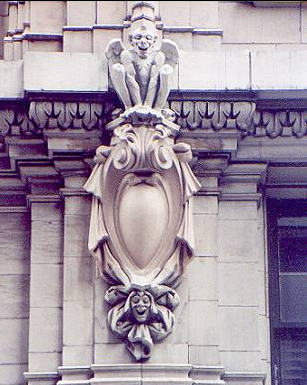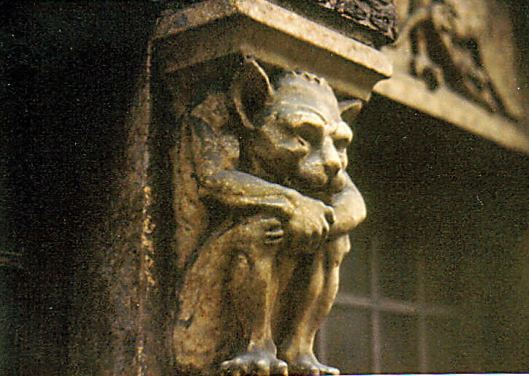A hat-tip to Christophe Thill, who has pointed out the existence of an interesting octopoid bas-relief from Equador, South America. It seems that this has been written about before as a possible source for the figurine in “The Call of Cthulhu”. Nothing shows up on Google Books or Amazon Look Inside, so possibly there is an essay on this in Lovecraft Studies, Crypt of Cthulhu etc. But those are very expensive now, and I don’t have access to them. So here’s my quick re-tracking down of some of the key facts and images…


Both from The Antiquities of Manabi, Equador (1907) (Incidentally, an excellent example of why scanned books should not be discarded after mass scanning — the picture quality is rubbish).

The same picture given again in G. Eliot Smith’s book Evolution of the Dragon (1919). It has eight “arms” like an octopus, even though the arms are very straight rather than curvy.

Lovecraft’s own pen-sketch of the Cthulhu figurine in the story.
Frank Belknap Long’s major mythos story “The Horror from the Hills” was written 1929, and first appeared as a two-parter in Weird Tales, Jan & Feb 1931. It is set in a New York museum, and Long mentions ‘The Manabi monoliths’. Although Lovecraft apparently gave written permission for one of his dreams [given in, among others, a letter to B.A. Dwyer of Nov. 1927] to be used in the story, as far as I can tell the story was not one of Lovecraft’s revision works. The late date and the seemingly tangential Lovecraft involvement thus suggests that there’s no actual proof that the Lovecraft circle may have known about the South American Manabi sculptures before 1927/9. Possibly some of Manabi works were on show in museums Long visited to research the story.
Yet… the Evolution of the Dragon was called a “highly acute and sensitive” (The Nation, 1919) work in the reviews of the time, and was even reviewed in Nature (1919), so it would seem strange if Lovecraft had not badgered the Providence library to obtain a copy. Or later tried to obtain a copy when he haunted the used bookshops and libraries of New York. Christophe Thill says that… “A picture of it [the Manabi octopoid] was published in Nature in 1924″, so it was obviously commented on. It is certainly very suggestive in the respect of the 1919 date that the famous entry in the Commonplace Book (entry No. 25, circa 1919, from a dream) describes not a squatting figure but a bas-relief like the one shown in Evolution of the Dragon…
“25. Man visits museum of antiquities — asks that it accept a bas-relief he has just made—old and learned curator laughs and says he cannot accept anything so modern. Man says that ‘dreams are older than brooding Egypt or the contemplative Sphinx or garden-girdled Babylonia’ and that he had fashioned the sculpture in his dreams. Curator bids him shew his product, and when he does so curator shews horror. Asks who the man may be. He tells modern name. “No — before that” says curator. Man does not remember except in dreams. Then curator offers high price, but man fears he means to destroy sculpture. Asks fabulous price — curator will consult directors. Add good development and describe nature of bas-relief.”
He is unlikely to have seen the squatting Manabi figure in the 1907 monograph, and it was not given in the book Evolution of the Dragon. So where might he have had it from? There are of course a great many similarly squatting and pedestal-seated Ancient Egyptian figures, and this seems an obvious source for an Egyptomaniac like Lovecraft. For instance, there are some human figures in that pose, many squatting baboon sculptures from Ancient Egypt from all periods, and the Egyptian sculptures of Bes mostly have the typical pose of squat with hands resting on knees. Lovecraft would have seen these illustrated in books on Egypt, and then by the time of writing “Cthulhu” would have seen plenty of actual examples in the New York museums…

Note the beard of Bes, which almost suggests octopus-like tentacles.




One might also point to the gargoyles of New York as another possible inspiration for the squatting figure of the Cthulhu statuette, especially the wings…


I know almost nothing of the roots of Masonic beliefs, but it may be that some scholar has reliably traced gargoyles back to guilds of masons whose traditions recalled those of Egyptian sculpture at the time of Rome? Whatever the truth of that, Lovecraft would certainly have made the Egyptian connection in his mind when he saw them on the buildings.
“The huge variety of nymphs, grotesques, demons, gargoyles, and other mysterious creatures carved into the facades of New York buildings is pretty astounding.” Ephemeral New York blog, 12th January 2011.

I don’t know whether it is germane to the discussion, but entry #25 of the Commonplace Book is a transcription of a dream that HPL had.